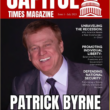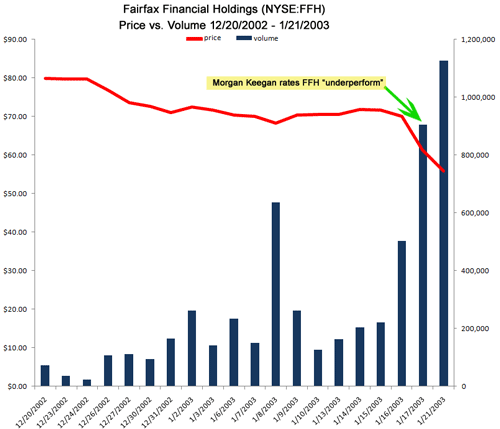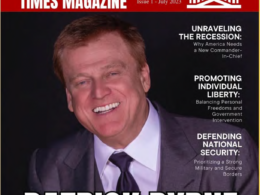Investigative financial reporter Teri Buhl says hedge funds are scrambling to put as much distance as possible between themselves and the increasingly radioactive SAC Capital, which is rumored to be the next target of the FBI’s crackdown on insider trading. According to Buhl, this includes purging email exchanges with SAC.
Funds like Blue Ridge, Greenlight, Third Point, Glenview, and Maverick are cutting back on any contact with [SAC Capital’s Steve Cohen]. When we asked major players such as [President of hedge fund Kynikos Associates] Jim Chanos and others if they’ve been pinging Stevie about a trade lately, you’ll get a very defensive ‘no.’
…Extra measures are being taken to hire data-miners to comb through any and all emails firms and their trading consultants ever sent to anyone at SAC in an attempt to erase them from internet memory.
If true, hedge funds Third Point and Kynikos will find it quite impossible to delete all their correspondence with SAC, given DeepCapture.com possesses several emails which, it just so happens, implicate all three funds in insider trading of a different sort; specifically, influencing and trading ahead of an analyst’s report.
DeepCapture.com first reported on this situation nearly one year ago, but I feel it’s worth revisiting and updating this topic, given recent developments.
Here’s the short version: in late 2002, a group of short-selling hedge funds, led by Kynikos Associates, learned from a Morgan Keegan analyst that he was preparing to initiate very pessimistic coverage of Canadian insurance company Fairfax Financial Holdings (NYSE:FFH). Kynikos promptly alerted SAC Capital and Third Point Partners about this prime shorting opportunity. In the days that followed, traders at Kynikos and SAC met with the analyst, reviewed and offered input on drafts of his forthcoming report, and, together with Third Point Partners, built up large short positions in Fairfax, which they very profitably covered following the report’s publication.
In one particularly telling email, a SAC trader sends an email to Steve Cohen himself, in which he explicitly states that SAC will cover their Fairfax short position following the Morgan Keegan report’s publication.
Here’s the long version: Fairfax Financial Holdings was first listed on the NYSE on December 20, 2002. During its first 15 trading days there, volume averaged well under 180,000 shares.
Then, on January 16, 2003 FFH volume exceeded 500,000 shares on an otherwise uneventful day in the life of a Canadian insurance company.
The next day, January 17, 2003 Morgan Keegan analyst John Gwynn initiated coverage of FFH with a scathing report and rating of “underperform”, making for one of the more eventful days in the lives of Fairfax shareholders, as their investments took heavy losses on extremely high volume.
Because information drives markets, one would expect to see extra activity in the wake of new information, such as that introduced by Gwynn on the 17th.
But what accounts for the unusually high volume observed the day before Gwynn’s report was published?
The answer to that question would come in October of 2008, when Morgan Keegan announced that Gwynn had been terminated for sharing his unpublished research on Fairfax with a small group of short-selling hedge funds.
Gwynn’s termination appears to be linked to the lawsuit Fairfax filed against several firms, including SAC, Third Point and Morgan Keegan alleging racketeering.
Email and trading data obtained through discovery in that suit conform that hedge funds Kynikos, Third Point, and SAC Capital all traded ahead of this material, non-public information.
It all started on December 11, 2002 when Kynikos employee Mark Heiman alerted Chanos that he had just learned from an analyst at Ziff Brothers Investments that a Morgan Keegan analyst was about to publish a negative report on Fairfax.
From: Mark Heiman (Kynikos Analyst)
Sent: December 11, 2002 11:06 PM
To: James Chanos (Kynikos President), Douglas Millett (Kynikos COO)
Subject: Fairfax
——————————————————————-
I just got off the phone with ZBI’s insurance analyst, Michael Ting. He just talked to a new insurance analyst at Morgan Keegan, and apparently that analyst is about to initiate FFRX at “Underperform,” with the thesis being that they are extremely under-reserved into the $3-$5 BN area. Also, there may be an article in Forbes or Fortune soon that will be similarly critical.
Ting said he thought that analyst was one of the best P&C analysts he has talked to, and wanted to give us the heads-up, as well as hear how we’re coming at it.
The next day, Kynikos employee Matt Cantrell apparently contacted Gwynn, as he sent Ting several documents relating to Fairfax subsidiaries, with the comment, “John Gwynn believes these might be of interest to you.”
Four days later, Heiman spoke to Gwynn personally, having a conversation which he summarized in the following report to Chanos:
From: Mark Heiman (Kynikos Analyst)
Sent: December 16, 2002 4:46 PM
To: James Chanos (Kynikos President), Douglas Millett (Kynikos COO), Charles Hobbs (Kynikos Managing Partner)
Subject: Fairfax
——————————————————————-
Just spoke to John Gwinn at Morgan Keegan, and he was more critical of FFRX than I’ve ever heard a sell side analyst. It looks like his criticisms of from the top to the bottom–everything from underwriting to accounting to dishonesty. He gave me his basics, as he is somewhat restricted because he hasn’t officially launched. It will be interesting to see how much of this the people who run the research department there will let him publish!
On December 18, 2002, Chanos forwarded Heiman’s email to Jeff Perry, then a senior portfolio manager at SAC Capital.
The day after Fairfax began trading on the NYSE, Gwynn’s revelations became much more explicit as he shared with Kynikos employee Heiman portions of his forthcoming report on Fairfax.
From: Mark Heiman (Kynikos Analyst)
Sent: December 21, 2002 6:03 PM
To: James Chanos (Kynikos President), Douglas Millett (Kynikos COO), Charles Hobbs (Kynikos Managing Partner)
Subject: Fairfax
——————————————————————-
Last night John Gwinn at Morgan Keegan faxed over to me an outline detailing the issues at FFH, basically those he will be publishing on. He has been a huge help and even offered to talk to me from his home today. We can look at these and talk to him next week–I just wanted to come in today and take a look at what he sent to get a head start on what he sent.
In the days to follow, Gwynn and SAC Capital Portfolio Manager Forrest Fontana held a face to face meeting where they discussed Fairfax.
Fontana followed up on that meeting via email to Gwynn:
From: Forrest Fontana (SAC Portfolio Manager)
Sent: January 06, 2003 8:57 AM
To: John Gwynn (Morgan Keegan Analyst)
Subject: RE: hope you had a nice holiday!
——————————————————————-
you available to touch-base on Fairfax sometime this week?
Followed by Gwynn’s prompt and eager reply:
From: John Gwynn (Morgan Keegan Analyst)
Sent: January 06, 2003 9:01 AM
To: Forrest Fontana (SAC Portfolio Manager)
Subject: RE: hope you had a nice holiday!
——————————————————————-
Name the time.
Fontana proposed a conversation the following day and requested a spreadsheet summarizing Gwynn’s analysis on Fairfax, which Gwynn promised to send.
On January 13, 2003 Fontana sent his boss, Steven A. Cohen himself, a summary of his planned activities for the week, which included:
Tuesday 1/14: Morgan Keegan expected to launch on Fairfax with sell rating – we will be covering into this.
As it turns out, Gwynn’s report was published on the 17th of January, not the 14th as Fontana expected. Still, it’s clear that SAC Capital was formally planning to trade ahead of the information received by Gwynn.
Trading records produced by Kynikos and Third Point all tell the same story: heavy short selling in anticipation of Gwynn’s report, and highly profitable short covering in the days that followed.
What did John Gwynn get out of all this? That’s unclear, though upon his firing, Morgan Keegan went to great lengths to say that Gwynn’s opinions were his own and not influenced by the hedge funds that profited from advance knowledge of them. We’ll likely never know more than that, as Gwynn reportedly passed away earlier this year.
The next question is: did Morgan Keegan get anything out of this arrangement?
The answer is yes: On December 21, 2002, the day after Kynikos received Gwynn’s unpublished analysis, Kynikos COO Douglas Millett declared his intention to begin sending business to Morgan Keegan.
Apparently, that’s how big hedge funds like Kynikos operate, which makes Chanos, who is also head of the Coalition of Private Investment Companies, the logical person to lobby Congress as that body considers long-overdue reforms.
A few weeks after these emails were initially published here on DeepCapture.com, the Wall Street Journal reported “The Securities and Exchange Commission is investigating whether several hedge funds traded improperly after being given advance notice by a research analyst of his negative report on a prominent insurer.”
At the time, I made it clear that if anything became of that investigation, I would publicly eat my hat…not because of a lack of evidence of wrongdoing on the part of these hedge funds, but because — consistent with its captured state — it goes against the SEC’s culture to take action against big players.
Had these been small hedge funds acting illegally, the SEC’s version of civil justice would have most certainly been both swift and sternly-worded.









The SEC is dying for all of us alfalfa-chewing rubes to believe insider info-based trading is the exception and not the rule.
Even the most oblivious observer would be a tough sell for that proposition.
No financial model in the world accounts for the exponential growth in assets these funds have experienced, along with a return that is not only outsized, but consistent. We already saw one, Madoff, blow up. This is no mystery to the regulators either. They know. And it just isn’t naked shorting. It all the lovely tricks that go along with it. Now who say this, let it all happen, and how were they compensated? Check out Dodd’s leading contributor. What a surprise, SAC Capital.
Everybody turns a blind eye. Nobody sees anything. Just a few guys who get called out as radicals, lunatics. How we lookin’ now?
Can we assume that the children of the children of the congressmen are financially set for decades to come?
Sadly, I think we can.
There used to be a tool where you could type in a website and it would give you all the Wikipedia edits made from people in the same class C as that website.
It showed that someone from SAC had made a large number of edits on stock related wiki posts. One that I found interesting was a post from someone at SAC about this strategy, SWAPS.
You agree to pay the interest on $1 million that you don’t receive in exchange for your prime brokerage agreeing to give you the upside on a stock you are shorting.
Since the two sides of the trade have equal value and cancel out, it is off balance sheet and neither side has to disclose the obligation.
Effectively, you’ve received insurance for the price of prime rate interest that you can use to hedge your short position and you can go naked short, because you’ve rented the prime brokerage’s ability to naked short and not bother settling trades.
Since you are collecting interest on the funds from the short sale, the insurance costs you nothing.
That tool is called the WikiScanner, and it’s not currently working, it seems.
However, if you know SAC Capital’s IP addresses, you can get the info by yourself.
Here are two of them: 167.206.132.252 and 69.74.41.252.
If you want to see the edit someone at SAC made, next to each date, click on the link that says “diff”. When you do, you’ll see a markup showing how the article was on the left and how it was changed on the right.
Here’s an interesting activity: start with this edit made by somebody at SAC. Then click on the link in the upper right quadrant that says “Next edit →”. Do that a few times and you’ll see somebody at SAC working pretty hard to clean things up, though in the end being unsuccessful.
I’m not faulting SAC for this, necessarily (I do think companies should have some input into their Wikipedia articles). But it is interesting.
Thanks Judd. I’m off to a Christmas party, but will spend some time with this over the holidays.
Then rinse and repeat and try with some of the other miscreant IP addresses.
These thieves are well connected, but they aren’t that swift technically and will lose in the end.
By the way, kudos on the Facebook connections. You took them off guard!
This is a sign that his tentacles that control is image are shortening and his friends are starting to leave his side. Under normal circumstances this would never have leaked out. It is over for him. Watch this video.
http://www.nypost.com/p/news/business/st_wife_clubbed_lwGOexXj3UOFOGCQKCMGvM
O M G… Steve Cohen IS George Castanza !
I am sure that these foriegn traders were the only one who profited from this deal!!RRRIIIGGGHHHTTTT!
Sanofi Bid for Chattem Leaked to Investors, SEC Says (Update1) Share Business ExchangeTwitterFacebook| Email | Print | A A A
By David Scheer
Dec. 23 (Bloomberg) — Sanofi-Aventis SA’s $1.9 billion bid for Chattem Inc., announced this week, was leaked in advance to two French investors who reaped $4.2 million by making illegal insider trades, U.S. regulators claimed in a lawsuit.
Nicolas Condroyer and Gilles Roger, both 33 and living in Brussels, amassed Chattem call options days before Paris-based drugmaker Sanofi unveiled the deal, then sold the holdings the day it was announced, the Securities and Exchange Commission said in a suit filed at federal court in Atlanta. The SEC didn’t say how they got the information. A judge froze their proceeds.
“These two men tried to take advantage of the marketplace and cash in on millions of dollars in illegal trades,” said William Hicks, an attorney at the SEC’s Atlanta office, in the statement. “Fortunately they were caught in the act.”
Hicks said no lawyers have yet come forward to represent the defendants. A call to a telephone number listed in a Brussels telephone book for N. Condroyer wasn’t answered. There was no listing in the Brussels directory for Gilles Roger.
Sanofi on Dec. 21 agreed to buy Chattem, the maker of Gold Bond medicated body powder, for $93.50 a share, sending the Chattanooga, Tennessee-based company’s stock up 33 percent that day. The deal will create the world’s fifth-largest consumer health company by revenue, Sanofi said….
rest of the story here..
http://www.bloomberg.com/apps/news?pid=20601087&sid=anX4W16CZ9cI&pos=7
The world of insidertrading is falling apart.. whose next Jim Chanos whose next?
By the way if the SEC could find out this within 2 WEEKS of the crime, what’s going on with the $1.7 million in Bear Stearns puts that yeilded 268 million in profits for the buyer back in March 0f 2008,and for way more than the 4.2 million here??Things that make you say hhhhmmmmnnnnn!!!!
If i worked for SAC and was just front-running big orders or just got calls from GS about big orders, Or how about the guys who use the phone to trade S&P’s or Gold,,You know they all were told to front run (FREE MONEY). I wonder if they all think they were being hear by FBI? Maybe I just take my bonus $$ and move along.
Wow! While reading this I stopped to watch Glenn Beck hosting a billionaire named Jon Huntsman and what he is up to in life. If all of it was true, heck if any of it was true, about how this guy does things, the contrast between the cheats like Cohen and Chanos is unreal. We get wore out by all the crooks.
It is nice to think there are some billionares who did it, and do it by the rules. For all our sakes we need to still have some honest men left who have played by the rules.
He is from Patrick’s homebase Salt Lake City. I hope he can back the good report if it is so.
I believe Patrick would agree with me in saying Jon Huntsman Sr. is great. His son, Jon Huntsman, Jr. was not much of a governor, but appears to be well suited to his current spot as ambassador to China. My wife is quite close to other members of the Huntsman family, and she holds them all in very high regard.
Madoff dying, secrets to go with him?
http://online.wsj.com/article/SB10001424052748704254604574614280225277724.html
Thank you for all of your work. Mr. Cohen stifled Reuters, but I’m glad that there are people like yourselves who cannot be stifled.
A movie exposing this? http://www.stockshockmovie.com
http://www.dollarsandsense.org/blog/2009/12/who-really-saved-global-economy.html
Sure you wanna play the market?
http://www.nytimes.com/2009/12/24/business/24trading.html?_r=2&pagewanted=all
Jim… EXCELLENT LINK..
————
“When you buy protection against an event that you have a hand in causing, you are buying fire insurance on someone else’s house and then committing arson.”
————
Banks Bundled Bad Debt, Bet Against It and Won
In late October 2007, as the financial markets were starting to come unglued, a Goldman Sachs trader, Jonathan M. Egol, received very good news. At 37, he was named a managing director at the firm.
Mr. Egol, a Princeton graduate, had risen to prominence inside the bank by creating mortgage-related securities, named Abacus, that were at first intended to protect Goldman from investment losses if the housing market collapsed. As the market soured, Goldman created even more of these securities, enabling it to pocket huge profits.
Goldman’s own clients who bought them, however, were less fortunate.
Pension funds and insurance companies lost billions of dollars on securities that they believed were solid investments, according to former Goldman employees with direct knowledge of the deals who asked not to be identified because they have confidentiality agreements with the firm.
….
“The simultaneous selling of securities to customers and shorting them because they believed they were going to default is the most cynical use of credit information that I have ever seen,” said Sylvain R. Raynes, an expert in structured finance at R & R Consulting in New York. “When you buy protection against an event that you have a hand in causing, you are buying fire insurance on someone else’s house and then committing arson.”
….. CONTINUED………
http://www.nytimes.com/2009/12/24/business/24trading.html?_r=3&pagewanted=all
All this hard investigative work is starting to pay off,it’s to bad that the money these stock swindlers got away with will never be recovered.
Was Reuters leaned on by Cohen? — I am definitely not an apologist for Cohen or Reuters, and I do believe many news outlets are unduly influenced by the perps. But the report that Cohen leaned on Reuters is a bit thin on evidence to that effect. Thomsen/Reuters may have wanted to wait until his ex wife actually filed a suit that was loosely threatened for quite a while. See
http://dealbreaker.com/2009/12/further-musings-on-the-ex-mrs.php
See for example
http://dealbreaker.com/2009/12/further-musings-on-the-ex-mrs.php?show=comments#comments
The guy that someone needs to keep an eye on is John Paulson..
All that hype about his gold positions…
Lila, I agree with you 100% Nobody makes 3.7 billion without cheating. He is the “Sith Lord” in my book. Stevie a 2nd placed criminal after Paulson.
Fred, sorry but nothing in you 2 previous post suggests that Cohen did not bully Reuters to stem the truth from coming out!!NOTHING. So please come again with better supporting evidence or …
Funny how the top cops in this country can solve almost any crime when they put their minds to it. The most popular shows on tv depict dedicated scientists working tirelessly in laboratories, poring over microbes and bits of dna to deduce whodunit. But when it comes to the simple math and glaring instances of opportunity/benefit concerning the biggest financial crimes in history, they are left scratching their heads.
Hey, wasn’t all this computerization supposed to make it easier to track and punish market criminals?
Am I missing something?
http://wallstreetpit.com/13161-bernie-madoff-treated-for-serious-injuries-after-assault
The insider trading cases are nice to see, and they say easier to prosecute. But so long as they treat naked short selling as if it simply is not there we will see no disgorging of billions in fraudulently stolen loot. In other words, there will be no justice for millions of investors whose assets were sheared and slashed by those with government license to prey on the rest of us. Thanks for keeping the pressure on, Judd.
sac wiki edits
http://katrina.cs.caltech.edu/erenrich_rnd345/scanner_final/company_selection.php?company_name=sac+capital
How surprising. little stevie cohen seems to be an unindicted felon. Who would have ever guessed. Opps. Looks like chanos is also. Anyone thinking about the criminals disgorging any ill gotten gains ought to forget about it. Look at Patrick’s results when to took down rocker. The fund was bankrupt. The loot was gone. “Where has all the money gone? Long time passin’.” Gone to fellow crooks via “losses” in prearranged unfavorable trades, and campaign contributions. That’s where. This country is as corrupt as a sleazy Panamanian border guard as Bunny Bob used to say.
this may be worth keeping an eye on:
“Dec. 26, 2009 Apolistic Life Church, Minister, Others Sued by Fifth Third
Defendant Mark Manuel Was Sued for Securities Fraud in Tennessee
By Tony Rutherford Huntingtonnews.net Reporter”
http://www.huntingtonnews.net/local/091226-rutherford-localfraud.html
THE TENNESSEE COMPLAINT
http://www.huntingtonnews.net/images/Digi_Manuel_reccd.pdf
APOSTOLIC LIFE COMPLAINT
http://www.huntingtonnews.net/images/Apos_Life_v_53_bank.pdf
Repeal of the Uptick Rule: A Planned Program to Obliterate the Stock Market
http://www.naturalnews.com/025003.html
On July 6, 2007, the day the uptick rule was repealed, the Dow Jones Industrial Average stood at 13,611, just three months away from its all-time high of 14,198. The timing of the repeal was absolutely perfect. Repeal of the uptick rule sent a clear signal to anyone paying attention that the party was now over and it was time to establish a short position to be sure of benefiting from the market’s coming drop.
The uptick rule prevented hedge funds and other professional traders from pushing the stock down by shorting, more shorting, and shorting again. Without the protection of the uptick rule, once a stock is selected by short sellers its fate is sealed. When market participants see an otherwise desirable stock plunging at the hands of short sellers, they become wary and afraid there is something seriously wrong at the company. In self defense, they sell their stocks and take their money out of the market. As this type of selling spreads, panic becomes rampant throughout the entire market. This is the kind of panic selling we have seen in the U.S. and world markets since September of this year.
Naked Short Sales Hint Fraud in Bringing Down Lehman
http://www.bloomberg.com/apps/news?pid=20601109&sid=aB1jlqmFOTCA
As Lehman Brothers Holdings Inc. struggled to survive last year, as many as 32.8 million shares in the company were sold and not delivered to buyers on time as of Sept. 11, according to data compiled by the Securities and Exchange Commission and Bloomberg. That was a more than 57-fold increase over the prior year’s peak of 567,518 failed trades on July 30.
The SEC has linked such so-called fails-to-deliver to naked short selling, a strategy that can be used to manipulate markets. A fail-to-deliver is a trade that doesn’t settle within three days.
“We had another word for this in Brooklyn,” said Harvey Pitt, a former SEC chairman. “The word was ‘fraud.’”
Patrick said it best
Take out a fire insurance policy on your neighbor’s house, and then set fire to it, knowing that no one will do anything other than pay you as the beneficiary.
This is what the story should be to the American Public. It covers CDS, naked short selling, flash trading – all of it. Take it all away and the average fund manager is no better than a chimp.
The talking point is easy to understand – thanks.
Excellent beat ! I wish to apprentice while you amend your web site, how could i subscribe for a blog website?
The account helped me a acceptable deal. I had been tiny bit acquainted of this your
broadcast provided bright clear idea